
The Firs is a country house in Whitchurch, Buckinghamshire.

The Firs is a country house in Whitchurch, Buckinghamshire.
The house was built in 1897 for Charles Gray, an officer who fought with the Imperial Yeomanry in South Africa. [1] By the 1930s the house was owned by Major Arthur Abrahams from whom it was requisitioned by the War Office in 1939. [2] During the Second World War the house was used by MD1 for the development and testing of various weapons [3] including time delay fuses, depth charges and PIAT guns. [4] The house, which was known locally as "Winston Churchill's Toyshop", accommodated some 250 people at this time. [5] Meanwhile Abrahams was knighted for his services to the British Red Cross in June 1942. [6]
In around 1953 the house became the Central Research Laboratories for Richard Thomas and Baldwins, iron and steel producers. [7] This use continued until 1967 when Richard Thomas and Baldwins was nationalised as part of British Steel. [7] The house has since been converted into offices [4] and in 2016 was owned by Christopher Mann, Chairman of Plenham Publishing. [8]

Sir Winston Leonard Spencer Churchill, was a British statesman who served as Prime Minister of the United Kingdom from 1940 to 1945, during the Second World War, and again from 1951 to 1955. Best known for his wartime leadership as Prime Minister, Churchill was also a Sandhurst-educated soldier, a Boer War hero, a Nobel Prize-winning writer and historian, a prolific painter, and one of the longest-serving politicians in British history. Apart from two years between 1922 and 1924, he was a Member of Parliament (MP) from 1900 to 1964 and represented a total of five constituencies. Ideologically an economic liberal and imperialist, he was for most of his career a member of the Conservative Party, which he led from 1940 to 1955. He was a member of the Liberal Party from 1904 to 1924.
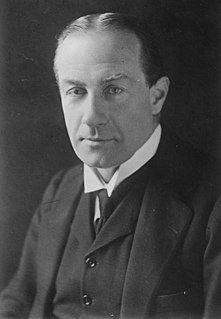
Stanley Baldwin, 1st Earl Baldwin of Bewdley, was a British Conservative statesman who dominated the government of the United Kingdom between the world wars, serving as Prime Minister on three occasions, from May 1923 to January 1924, from November 1924 to June 1929, and from June 1935 to May 1937.
Pitchcott is a village and civil parish in the Aylesbury Vale district of Buckinghamshire, England. It is about 3 miles (5 km) northeast of Waddesdon, slightly less than 4 miles (6.4 km) south of Winslow and slightly more than 4 miles (6.4 km) north of Aylesbury. It is in the civil parish of Oving.

Whitchurch is a village and civil parish in the unitary authority area of Buckinghamshire, England. The village is on the A413 road about 4 miles (6.4 km) north of Aylesbury and 4.5 miles (7 km) south of Winslow. The 2011 Census recorded a parish population of 932.

Frederick Alexander Lindemann, 1st Viscount Cherwell, was a British physicist who was prime scientific adviser to Winston Churchill in World War II.
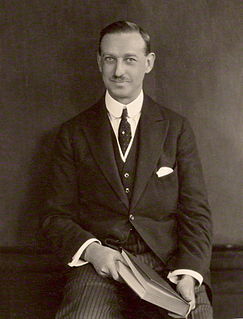
James Richard Stanhope, 7th Earl Stanhope,, styled Viscount Mahon until 1905, and known as the Earl Stanhope from 1905 until his death, was a British Conservative politician.
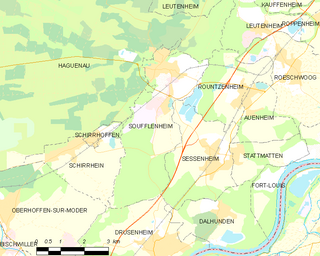
Operation Royal Marine was a military operation in May 1940 of the Second World War, during the Battle of France. The British floated fluvial mines down rivers which flowed into Germany from France. The plan was to destroy German bridges, barges and other water transport. After several postponements insisted on by the French government, fearful of German retaliation, the operation began on 10 May 1940, when the German offensive in the west began.

The Gathering Storm is a BBC–HBO co-produced television biographical film about Winston Churchill in the years just prior to World War II. The title of the film is that of the first volume of Churchill's largely autobiographical six-volume history of the war, which covered the period from 1919 to 3 September 1939, the day he became First Lord of the Admiralty.

The Blacker Bombard, also known as the 29-mm Spigot Mortar, was an infantry anti-tank weapon devised by Lieutenant-Colonel Stewart Blacker in the early years of the Second World War.
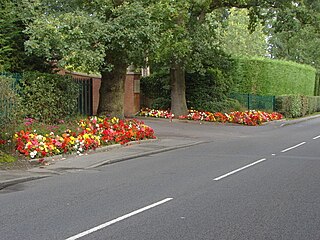
Windlesham Moor is a country house and, for a time in the 20th century a royal residence, at Windlesham in the English county of Surrey. In its capacity as a royal residence, it was, for nearly two years in the late 1940s, the home of Princess Elizabeth and her husband Philip, Duke of Edinburgh.
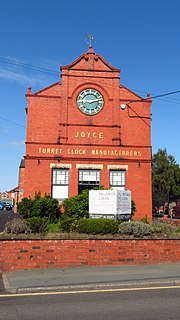
J. B. Joyce & Co, clockmakers, were founded in Shropshire in England. The company claim to be the oldest clock manufacturer in the world, originally established in 1690, and have been part of the Smith of Derby Group since 1965. The claim is challenged by another English firm of clockmakers, Thwaites & Reed, who claim to have been in continuous manufacture since before 1740, with antecedents to 1610.

Winston Churchill received numerous honours and awards throughout his career as a British Army officer, statesman and author.
The Firs may refer to:

The Churchill war ministry was the United Kingdom's coalition government for most of the Second World War from 10 May 1940 to 23 May 1945. It was led by Winston Churchill, who was appointed Prime Minister by King George VI following the resignation of Neville Chamberlain in the aftermath of the Norway Debate.
Sir Millis Rowland Jefferis KBE MC was a British military officer who founded a special unit of the British Ministry of Supply which developed unusual weapons during the Second World War.
Colonel Robert Stuart Macrae TD was an inventor best known for his work at MD1 during the Second World War, his best known invention being the sticky bomb.
Ministry of Defence 1 (MD1), also known as "Churchill's Toyshop", was a British weapon research and development organisation of the Second World War.

The statue of Winston Churchill in Parliament Square, London, is a bronze sculpture of the former British prime minister Winston Churchill, created by Ivor Roberts-Jones.

Chalfont Park, formerly known as Brudenells and Bulstrodes, is an English country house and estate near the village of Chalfont St Peter in Buckinghamshire.